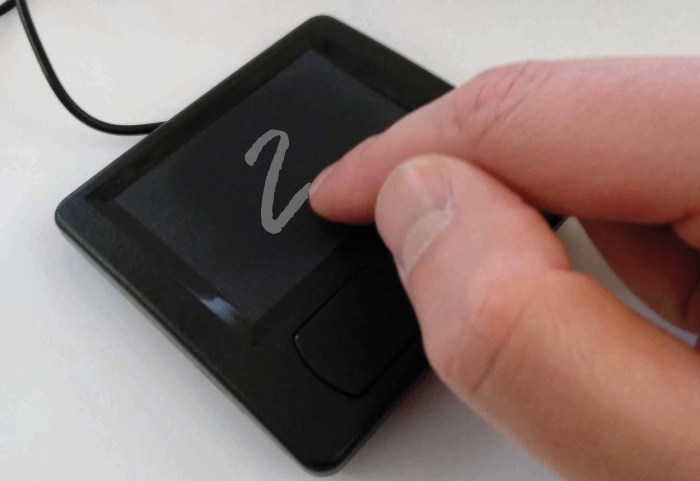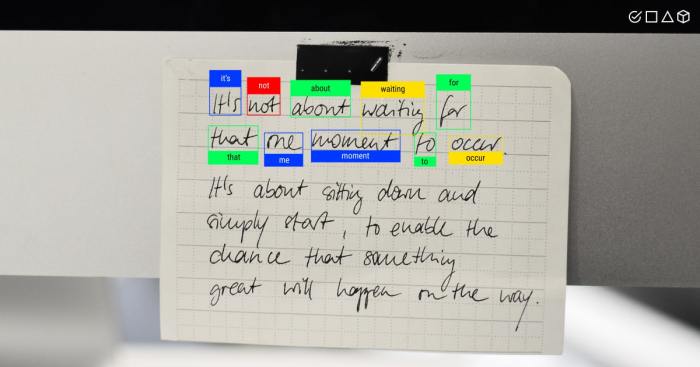Evolution of Handwriting Recognition
Imagine a world where computers could understand your handwritten notes, effortlessly transforming them into digital text. This futuristic vision has been a driving force in the field of handwriting recognition, a technology that has evolved significantly over the years. From its humble beginnings to the sophisticated AI-powered systems of today, handwriting recognition has come a long way, shaping various industries and making our lives easier.
Early Attempts and Challenges
The quest to decipher handwritten text began long before the advent of computers. Early attempts focused on developing mechanical devices that could interpret handwriting, but these efforts were hampered by the complexity of human writing styles and the limitations of the technology available at the time.
One notable example is the “Optical Character Recognition” (OCR) technology developed in the 1950s. This technology utilized specialized hardware to scan and recognize characters, but it was limited to recognizing printed text and struggled with the nuances of handwritten scripts.
Traditional handwriting recognition methods faced numerous challenges, including:
- Variations in Writing Styles: Every individual has a unique handwriting style, making it difficult for algorithms to generalize across different writers.
- Handwriting Variability: Even the same person’s handwriting can vary depending on factors like writing speed, pen pressure, and writing surface.
- Ambiguity and Noise: Handwritten text can be ambiguous, with letters often overlapping or poorly formed, and noise from background elements can further complicate recognition.
Despite these challenges, early attempts paved the way for future advancements in the field.
The Rise of AI in Handwriting Recognition
The world of handwriting recognition has undergone a dramatic transformation with the advent of artificial intelligence (AI). AI algorithms, particularly deep learning, have revolutionized the way we analyze and interpret handwritten text, leading to more accurate, efficient, and versatile systems.
The Power of Deep Learning
Deep learning, a subset of AI, has proven to be a game-changer in handwriting recognition. It empowers computers to learn complex patterns from vast amounts of data, mimicking the human brain’s ability to recognize and interpret handwritten characters. Deep learning models, such as convolutional neural networks (CNNs), are trained on massive datasets of handwritten text, enabling them to identify intricate features, variations in handwriting styles, and even subtle nuances that traditional methods struggled to capture.
Key Features and Advantages of AI-Powered Handwriting Recognition, Seeing ai updated handwriting recognition
AI-powered handwriting recognition systems offer a range of advantages over traditional methods.
- Enhanced Accuracy: Deep learning algorithms can achieve significantly higher accuracy rates compared to traditional methods, particularly in recognizing complex handwriting styles and handling variations in writing pressure and slant.
- Improved Speed: AI-powered systems can process handwriting data much faster than traditional methods, thanks to their ability to analyze large amounts of data in parallel.
- Adaptability and Scalability: AI models can be easily adapted to different handwriting styles and languages, making them highly scalable for diverse applications.
- Reduced Error Rates: AI systems can continuously learn and improve their performance over time, leading to a significant reduction in error rates.
- Offline Capabilities: Some AI-powered handwriting recognition systems can operate offline, enabling users to capture and analyze handwritten text even without internet connectivity.
Traditional vs. AI-Based Handwriting Recognition
Traditional handwriting recognition methods relied heavily on rule-based approaches and statistical models. These methods often struggled with complex handwriting styles, variations in writing pressure, and noisy data. AI-based systems, on the other hand, leverage deep learning algorithms to learn complex patterns from data, enabling them to handle diverse handwriting styles, adapt to changing conditions, and achieve significantly higher accuracy rates.
| Feature | Traditional Methods | AI-Based Methods |
|---|---|---|
| Accuracy | Lower accuracy, particularly with complex handwriting styles | Higher accuracy, capable of handling diverse handwriting styles |
| Speed | Slower processing times | Faster processing speeds due to parallel data analysis |
| Adaptability | Less adaptable to different handwriting styles | Highly adaptable to various handwriting styles and languages |
| Error Rates | Higher error rates, especially with noisy data | Lower error rates due to continuous learning and improvement |
How AI Sees Handwriting: Seeing Ai Updated Handwriting Recognition
Imagine trying to decipher a child’s scribbles or a doctor’s messy notes. That’s the challenge AI faces when trying to understand handwriting. AI doesn’t see handwriting like humans do; it breaks down the information into patterns and data it can analyze.
AI systems use a combination of techniques to interpret handwritten text. First, they need to convert the image of the handwriting into a format they can understand. This involves converting the image into a digital representation, like a grid of pixels. Then, they analyze the image, identifying features like the shape of letters, the spacing between them, and the overall writing style. This process, called feature extraction, is crucial for AI to understand the nuances of handwriting.
Feature Extraction and Classification
Feature extraction is like identifying key elements in a handwriting sample. AI systems look for specific features, such as the height, width, and curvature of letters, as well as the relative positions of letters within words and words within sentences. These features are then used to classify the handwriting, essentially categorizing it into different types of letters and numbers.
For instance, a ‘T’ might be identified by its vertical line and horizontal bar, while an ‘O’ might be characterized by its circular shape. The AI system uses these features to determine the most likely character based on the extracted information.
Types of AI Models for Handwriting Recognition
Different types of AI models are used for handwriting recognition, each with its own strengths and weaknesses.
- Convolutional Neural Networks (CNNs) are known for their ability to identify patterns in images. They excel at recognizing shapes and structures in handwritten text, making them highly effective for character recognition. CNNs are particularly adept at handling complex handwriting styles, like cursive writing.
- Recurrent Neural Networks (RNNs) are designed to process sequential data, such as text. They can analyze the order of characters in a word or sentence, which is essential for understanding the context and meaning of the handwritten text. RNNs are particularly useful for recognizing handwriting that has variations in letter formation and spacing.
AI models like CNNs and RNNs are constantly learning and improving their ability to recognize handwriting. They are trained on massive datasets of handwritten text, allowing them to learn the subtle variations in handwriting styles and patterns. This continuous learning process enables AI systems to become more accurate and reliable over time.
Applications of AI-Powered Handwriting Recognition
AI-powered handwriting recognition is not just a technological marvel; it’s a game-changer across various industries. This technology empowers businesses and individuals to automate tasks, improve efficiency, and unlock new possibilities by translating handwritten text into digital format.
Applications of AI-Powered Handwriting Recognition Across Industries
AI-powered handwriting recognition has a wide range of applications across various industries, transforming how we work and interact with information. Here’s a glimpse into how this technology is revolutionizing different sectors:
| Industry | Specific Application | Benefits |
|---|---|---|
| Healthcare | Medical records digitization | Reduces manual data entry errors, improves patient data accessibility, facilitates faster diagnosis and treatment |
| Education | Automated grading of handwritten exams and assignments | Saves teachers time, provides consistent and objective feedback, allows for personalized learning experiences |
| Finance | Processing of handwritten checks and financial documents | Streamlines financial transactions, reduces processing time, improves accuracy and security |
| Document Processing | Digitization of handwritten forms and contracts | Automates document capture and indexing, improves data accuracy, enables efficient document management |
| Retail | Real-time analysis of customer feedback and surveys | Gathers valuable customer insights, improves product development, enhances customer satisfaction |
| Legal | Transcription of handwritten legal documents and evidence | Reduces manual transcription errors, improves case management efficiency, enhances legal document accessibility |
| Logistics | Automated data entry for delivery notes and invoices | Streamlines logistics operations, improves delivery accuracy, reduces manual errors |
| Government | Digitization of handwritten citizen applications and forms | Improves citizen service efficiency, reduces processing time, enhances data accuracy and security |
Real-World Use Cases
These applications are not just theoretical concepts; they are actively implemented in real-world scenarios. Here are some examples:
- Healthcare: Hospitals use AI-powered handwriting recognition to digitize patient medical records, reducing errors and improving data accessibility for doctors and nurses.
- Education: Universities employ this technology to automate the grading of student assignments, freeing up professors’ time for more personalized interactions with students.
- Finance: Banks leverage AI to process handwritten checks, ensuring faster and more secure financial transactions.
- Document Processing: Insurance companies use AI to digitize handwritten claim forms, streamlining the claims process and improving efficiency.
Future Trends in Handwriting Recognition
The field of handwriting recognition is constantly evolving, driven by advancements in AI and related technologies. The future holds exciting possibilities for even more accurate, efficient, and personalized handwriting analysis.
Integration of Natural Language Processing (NLP)
NLP plays a crucial role in understanding the meaning and context of handwritten text. Integrating NLP with handwriting recognition systems can enhance accuracy and provide deeper insights into the content. For example, NLP can help differentiate between similar-looking characters based on the surrounding words and the overall context of the text.
Advancements in Computer Vision
Computer vision techniques are essential for interpreting images of handwritten text. Advancements in computer vision, particularly deep learning algorithms, are leading to more robust and accurate handwriting recognition systems. These algorithms can learn complex patterns and features from large datasets of handwritten text, enabling them to handle variations in handwriting styles and quality.
Real-Time Handwriting Analysis
Real-time handwriting analysis allows for immediate feedback and insights, making it valuable for various applications. For instance, real-time analysis can be used for:
- Educational tools that provide instant feedback on handwriting quality and legibility.
- Live note-taking applications that convert handwritten notes into digital text.
- Interactive digital whiteboards that allow users to write and collaborate in real-time.
Personalized Handwriting Recognition
Personalized handwriting recognition systems are trained on individual handwriting styles, leading to higher accuracy and better user experiences. For example, a personalized handwriting recognition system could be used for:
- Secure authentication systems that verify users based on their unique handwriting patterns.
- Smart devices that learn individual handwriting styles for improved text input and personalized recommendations.
- Digital signature verification systems that can distinguish between genuine signatures and forgeries.
Seeing ai updated handwriting recognition – The future of handwriting recognition is bright, with AI leading the charge. As technology continues to evolve, we can expect even more sophisticated systems that understand not just the words we write, but also the nuances of our individual handwriting styles. From personalized learning experiences to seamless document processing, the potential applications are endless. So, next time you scribble a note, remember that AI is watching, learning, and transforming how we communicate and interact with the world around us.
Seeing AI updated handwriting recognition is like witnessing the evolution of a language. It’s incredible how it can now decipher even the most messy scribbles. Speaking of making things easier, you can now register to vote easily via twitter – just like how AI is simplifying the way we understand written words. This kind of progress makes you wonder what other advancements are just around the corner, ready to make our lives even smoother.
 Standi Techno News
Standi Techno News

